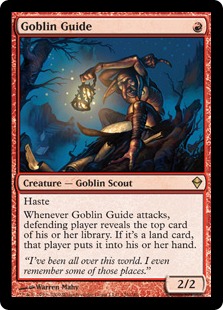One of the first cards that I noticed when I was looking at the Zendikar spoilers was easily this one:

I’ve seen a lot of opinions on this card. Some view it as the Second Coming. Now, I love the card, but that’s an exaggeration, certainly. Some view it as mostly crap. This doesn’t seem nearly generous enough to me. Last week, our own Ben Bleiweiss put it as a $4 rare. This also seems not strong enough.
Let’s take my own semi-famous dislike of the card Path to Exile. Clearly, my initial feelings on the card were too strong. I mostly didn’t like the card, essentially because it was a card you very rarely wanted to play incredibly early against an aggressive deck if you were a more controlling deck, and rarely wanted to play against a controlling deck if you were an aggressive one. The loss of card advantage and tempo would just be too much, I thought, for it to be the kind of staple that it has actually proven to be.
Goblin Guide is far less punishing than Path to Exile. Typically, a Goblin Guide will only give up the card advantage loss of a Path to Exile about 40% of the time. More importantly, though, it won’t give any direct tempo advantage to your opponent; even if they are getting the extra card from it, it won’t be in play. While it is true that this opportunity for advantage will be in play every time the Guide attacks, multiple Guides actually only barely stack onto each other (hitting at a rate, on average, of X+X*X, where X is your percent chance to hit — .56 cards, for example, is your EV for 2 Guides attacking a 40% land opponent). When life totals can threaten to drop so quickly, this potential for card advantage really does become mitigated.
And so, I’ve ended up with a ton of Goblin Guide decks. As I started working on them, I looked at what they would be like in deck after deck. Zoo was one that I particularly wanted to plug away at, ultimately coming to three builds of the archetype. Here they are:
Ranger Zoo
One of the most commonly played builds of Zoo by the end of the last season was the Naya-based Ranger Zoo, based largely on Tomoharu Saito’s build of the deck. Ultimately, it backs up the aggressive early drops that we’ve grown used to in Zoo builds of all kinds, and followed it up with Woolly Thoctar, and refilling the hand with Ranger of Eos. Putting all of this together generally meant that you’d never really find yourself running out of gas and you’d always have a very strong creature set at all times.
Adding Goblin Guide to the mix sets up some truly explosive post Ranger of Eos turns in the late game, should you get there. Often, an opponent will be falling back on their heels when you’re pushing them over the edge. The Guide also helps just get them to that point, even before you begin to lean on Ranger.
Here is my build of Ranger Zoo:
Creatures (26)
Lands (21)
Spells (14)

I’m sitting at 61 cards here, albeit unhappily. I know I need to cut one card. Maybe two Scutes is too cute. But a big part of me doesn’t think so. I’ve just had too many situations come down to, “Hey, I’ve got a Ranger, let’s get 2 Scute Mob, and if they don’t kill them, they’re doomed.” Hell, I’ve thought about 3 Scute Mobs. Everything else, though, strikes me as being the right number. Something should absolutely get cut, simply to make room. Literally, only Tarmogoyf, Wild Nacatl, and Lightning Bolt seem like they should be above consideration for the cut list. That does mean, though, that I’d be thinking of cutting the numbers of some really great card below the amount that I think would be appropriate.
Magic is just hard, sometimes.
With some more crunching, I’m sure that I’ll figure out which card is the right one to cut. I’ve always been a fervent believer in testing and testing with decks at this stage to get the right one. Merely eyeballing it is not good enough. If anyone has a good argument about which card should be cut, I’d love to hear about it in the forums. I know that Saito’s list only ran 3 Ranger of Eos, and maybe that is simply the correct cut, but somehow I just find it difficult to cut a card that seems to do so much work.
“Prosak” Zoo
Going a step further back in time, we come to Prosak Zoo. Adam Prosak really started people down the path that would eventually lead to the Saito style, above. Prosak’s Zoo, though, was very different than the list that Saito would bring to the world. Prosak’s build was interested in a very short game.
Dropping a quick clock and dumping the tiniest of land destruction is a classic strategy. One of the big differences between Ponza and Sped Red was that where Ponza was situated towards Midrange Beatdown (or, rarely, Midrange Control), Sped wouldn’t be so interested in controlling the game. Sped would just drop a clock and try to keep you off balance. In many ways, Red Deck Wins worked in this same vein (though I’d argue that RDW was what a Ponza deck had to become in that metagame), and Prosak works much the same way.
Goblin Guide seems particularly good for this strategy. While the deck does include an idea that some might call “nombos,” Goblin Guide and Molten Rain being the big key example. Remember, though, that Molten Rain in this deck is not trying to lock someone out of the game, in general, but rather is there to attempt to just draw out the early game a smidge longer. Goblin Guide doesn’t get in the way of this, actively; it does, however, put the “purely” screwed opponent in less of a bind, at times, but only if they are also able to find the answers they need. Ultimately, though, while I feel good about Guide, this deck might be the one that is best served by not running Guide.
Creatures (24)
- 4 Kird Ape
- 4 Keldon Marauders
- 4 Tarmogoyf
- 4 Wild Nacatl
- 1 Qasali Pridemage
- 3 Bloodbraid Elf
- 4 Goblin Guide
Lands (23)
Spells (13)

Twenty-three lands is a bit more than is being played in the Ranger Zoo list, mostly because of the importance of Molten Rain; you want to be dropping the Rain consistently on turn 3. Helping keep this less dangerous is a pair of Mutavaults.
Perhaps the strangest numbers here are the singleton Umezawa’s Jitte and Qasali Pridemage. With Bloodbraid Elf in the mix, running two Umezawa’s Jitte aren’t likely to knock into each other, but I’d prefer to just make them never hit each other by changing the second Jitte into a Pridemage. If you don’t care about this, change it over into another Jitte.
Bloodbraid Elf is largely here just to increase the relative numbers of what the deck is doing. In many ways, you’re almost running five copies of every card in the deck. One of the most exciting games I’d had started out with a Nacatl, and then a Marauders (taking them to 17), then a Molten Rain and Bloodbraid into Molten Rain. At the end of the assault, my opponent was just done.
Domain Zoo
Of course, Prosak Zoo was, in some ways, an attempt to return to the philosophy that fueled the Domain Zoo decks of long ago. Domain Zoo was primarily fueled by the ability to include Vindicate in their lists. Some of these decks ended up also including Molten Rain, giving a clear ancestry to Prosak. People shifted away from these lists, though, after Vindicate ran away.
Guide seems to return many of the incentives to the list, since it can really give a pick-me-up to the beatdown. Path to Exile also makes Domain Zoo a little smidge less scared of an opposing Jitte, though it can still be a real problem. It does seem like the sheer amount of super-cheap spells really increases the value of the other card that people used with the old Domain Zoo: Dark Confidant.
Here is my version of this old style Zoo list:
Creatures (20)
Lands (20)
Spells (20)

This list isn’t trying super-hard to exploit Might of Alara. You’ll see no Boros Swiftblades (though Viashino Slaughtermaster is slightly tempting). This list is playing super low on the curve, with 23 one-drops and 17 two-drops. There are a lot of lightning rods in this deck, so it’s not so difficult to keep a Dark Confidant on the table — there is always something else to kill…
This list is easily the riskiest of the lists. A lot can go wrong, certainly. At the same time, it is probably best set up to take advantage of an opponent who is unprepared for an aggressive deck. Especially early in a format, people sometimes are often insufficiently prepared for all manner of lines of attack. With aggressive decks, this sometimes simply means they aren’t prepared for the speed that a deck is capable of giving. This deck hopes to hop on that kind of opponent, and pound them in the face, hard.
Conclusion
Even without Goblin Guide, Zoo is going to be one of the big contenders. Anyone who has done some amount of work with the deck will recognize that there are some real issues for the deck. The mana is actually a little difficult with the new fetchlands. Only Arid Mesa is convenient, and sometimes the mana will chug a little more than one might like. Lightning Bolt is an auto-include in the deck, and really powers it up.
Goblin Guide does seem to set up Zoo for one real positioning problem: Engineered Explosives is all the better in a deck that adds Goblin Guide to Kird Ape and Wild Nacatl. Even so, if you are choosing to play around this properly, it shouldn’t hurt you too much. The payoff seems worth it to me.
Some, though, will decline to go with the Guide, and they’ll still have a great Zoo deck, I’m sure. That said, if you get a chance, try slipping a few in and see what you think. I don’t think every Zoo deck is properly built with 4 Guide, but I have come to the conclusion that it belongs in a great deal of them.
In the end, I guess we’ll mostly see it on the price tag. Either Goblin Guide is going to head upwards in the marketplace or it is going to stay on the low, low end of non-dime rares — playable but unexciting. I’m getting mine now, before they go up to something a little less cheap than the deal they seem to be now.
Until next week…

